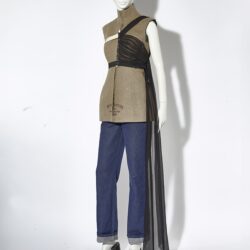Kindred Spirits: The radical poetry of Japanese and Belgian designers

From 18 October 2019 to 19 April 2020, the exhibition ‘Cool Japan’ at MAS will take you on a whirlwind tour of the global fascination for Japanese visual culture. Thanks to a number of unique loans from MoMu, you can get acquainted with Japanese and Belgian avant-garde fashion that revolutionised Parisian catwalks in the 1980s. Follow along as we explore how radical Japanese fashion inspired Belgium’s avant-garde and trace the creative influence between Japanese and Belgian designers.

From the moment the visionary spirit of Japanese designers was revealed to the world, in Paris in the early 1980s, it became perfectly clear that their work was much deeper than mere ‘rags’. Kenzo Takada and Issey Miyake had arrived in the French capital in previous decades, but in 1981 Yohji Yamamoto and Rei Kawakubo caused a real revolution with their autumn/winter collections, which they presented together. In contrast to the glamorous image of the power-woman then in vogue, the Japanese designers presented all-black clothes, which the most conservative critics claimed looked as though they had come out of a nuclear disaster. Polly Mellen, then editor of American Vogue, stated, ‘It is modern and free. It has given to my eyes something new and has made this first day incredible. Yamamoto and Kawakubo are showing the way to a whole new way of beauty’.
A new beauty, challenging the prevailing aesthetic conventions still based on the Western Renaissance conception of symmetry, balance and perfection. In fact, this ‘new’ aesthetic – an anti-aesthetic, according to many commentators – had its roots in the secular legacy of Japanese culture. They resonate in the avant-garde minds of Japanese designers such as Miyake, Kawakubo and Yamamoto, and their disciples, Junya Watanabe and Dai Fujiwara. The themes of perishability, absence (always accompanied by the immense power of suggestion, as in Haiku poetry, for example, where omission of words creates a possibility of meanings), irregularity, both simplicity and complexity, deconstruction to reconstruct, and the importance of meaning have permeated Japanese and Japanese culture for thousands of years. The shock they cause comes from our inability to look in the mirror and recognise that imperfection is inherent to the human condition.

This radical thinking translates into radical attires: garments reconstructed through the deconstruction of conventional patterns; monochromatic, focusing on ascetic and mysterious black; unusual volumes, sometimes over-sized proportions; asymmetry; overlapping; rips; seams and hems on the outside, taking part in the design process; unfinished garments; knots and bows as fastenings, keeping the pieces in place; faded boundaries between male and female. New lexicons of clothing were created and the essence of wabi-sabi present in the work of these Japanese aesthetes touched the soul of many young designers deeply. These young designers, who were looking for a new meaning to express their creativity through clothes, included the fashion students of the Royal Academy of Fine Arts in Antwerp, firmly trained in classical construction and cut.
I was just finishing my studies [when the Japanese designers had their European debut] and it was a brave new step in fashion – the beginning of a new freedom for me as a designer and as a woman.
The work of the Japanese designers, especially Yamamoto and Kawakubo, was both a shock and a revelation to Belgian designers, who at the time were still on the periphery of the international fashion scene. Confident that there would be other, less conventional ways than those of the established system, the revolutionary group left Antwerp for London in search of a stage receptive to the expression of their sartorial philosophy. So began a new wave that would rock the foundations of Western fashion and paradigms established by haute couture and already shaken by the Japanese designers.

One of the Belgian school would take the poetics of deconstruction initiated by the Japanese designers even further – Martin Margiela. Far from being a clone of his forerunners, Margiela found his own voice through a radical aesthetic: he maximised deconstruction and dissection of the garments, making this process a form of reflection; he moved elements, such as sleeves or collars, from their usual location and gave them new and unusual contexts. It was not only the final result that was important but also the design process and the various stages of production. It is fascinating to note that the element of perishability, underlined in the early works of Yamamoto and Kawakubo through the deconstructed nature of the garments – asymmetries, tears, frayed edges, knots, and uneven hems – is very present in the work of the Belgian designers, especially Martin Margiela.

Glamour was replaced by uniqueness. Mass production gave place to individuality. Expressing themselves freely, these designers, from two different cultures and different generations, contributed to the emergence of a ‘new’ aesthetic and to consolidate the idea that fashion can be an art form in its own right.





